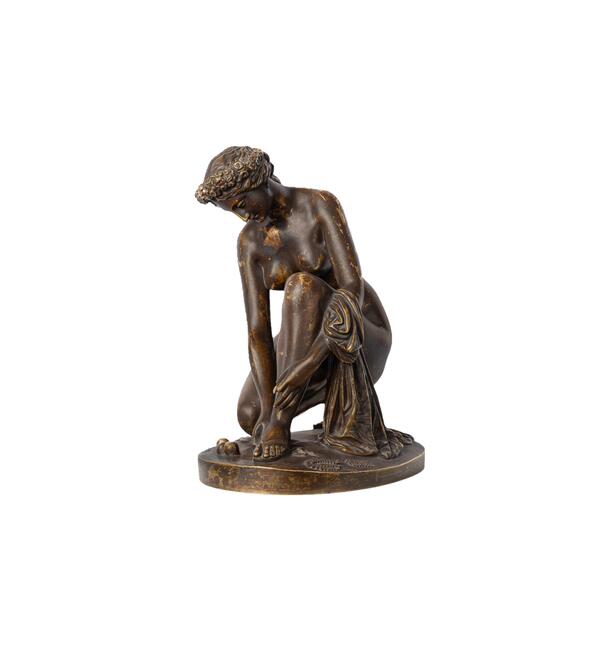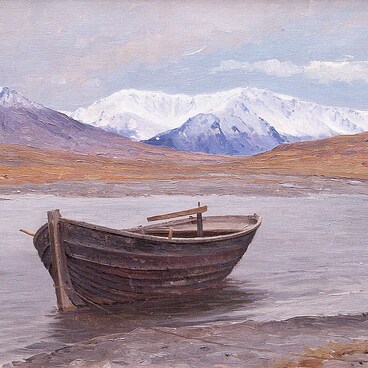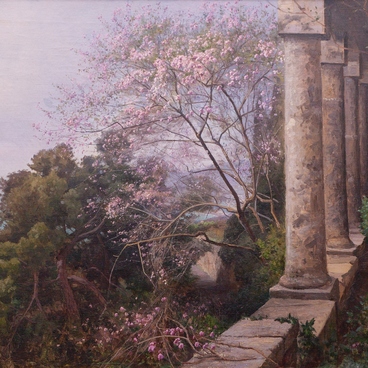The marble sculpture ‘The Toilette of Atalanta’ was presented at an exhibition at the Paris Salon in 1850. The audience did not recognize the cruel heroine from ancient Greek myths in the young girl grooming herself.
The Paris Salon was one of the most prestigious art exhibitions in France. It appeared during the reign of Louis XIV: the monarch ordered the Royal Academy of Painting and Sculpture to hold regular exhibitions of artworks. After the French Revolution, all artists, not only academicians, received the right to present their works at the Salon.
Atalanta’s father, who had desired a son, ordered the girl to be left in a dense forest. But goddess Artemis pitied the newborn and sent a she-bear to her, who fed and protected the baby. Atalanta survived and became a fierce hunter. She participated in the hunt for the Calydonian boar: her arrow first struck the beast, which was then killed by hero Meleager’s spear. According to one version of the myth, Atalanta participated in the voyages of the Argonauts, according to another, she gave Jason a spear. Later, she agreed to become the wife of the one who would outrun her in a footrace, but if the suitor was unsuccessful, he would be killed.
Sculptors and painters most often depicted Atalanta as a dexterous huntress, ‘the fastest among mortals’. Jean Jacques Pradier, the author of the presented statue, captured the beauty of the female body, which is not covered or draped. He presented the stern heroine in a gentle, almost erotic pose, for which he received many critical reviews. His ‘Atalanta’ was called ‘a Parisian woman coming out of the bathhouse’ and the public refused to recognize her as a harsh Greek woman. After the Paris Salon ended, the sculpture was housed in the Luxembourg Museum, and in 1854 it was transferred to the Louvre.
The author of the work, Jean Jacques Pradier was a French sculptor of Swiss origin. After graduation from a school in Paris, he studied ancient art in Rome for several years. Gustave Flaubert called him ‘a great artist, a true Greek’.
Prince Anatoly Demidov brought Pradier’s works to Russia. The prince met Juliette Drouet, the sculptor’s model and lover, in Paris, and she, in turn, introduced him to Pradier himself. Demidov bought several works from him, in particular the marble composition ‘Venus and Cupid’ for the Hermitage.
In the late 1920s, artworks from requisitioned private collections, as well as from the collections of major museums in Moscow and Leningrad, were transferred to provincial museums. Some paintings, sculptures and graphic works were delivered to Tomsk in 1932 from the State Museum of Fine Arts. Among them was this bronze copy of the sculpture ‘The Toilet of Atalanta’.
The Paris Salon was one of the most prestigious art exhibitions in France. It appeared during the reign of Louis XIV: the monarch ordered the Royal Academy of Painting and Sculpture to hold regular exhibitions of artworks. After the French Revolution, all artists, not only academicians, received the right to present their works at the Salon.
Atalanta’s father, who had desired a son, ordered the girl to be left in a dense forest. But goddess Artemis pitied the newborn and sent a she-bear to her, who fed and protected the baby. Atalanta survived and became a fierce hunter. She participated in the hunt for the Calydonian boar: her arrow first struck the beast, which was then killed by hero Meleager’s spear. According to one version of the myth, Atalanta participated in the voyages of the Argonauts, according to another, she gave Jason a spear. Later, she agreed to become the wife of the one who would outrun her in a footrace, but if the suitor was unsuccessful, he would be killed.
Sculptors and painters most often depicted Atalanta as a dexterous huntress, ‘the fastest among mortals’. Jean Jacques Pradier, the author of the presented statue, captured the beauty of the female body, which is not covered or draped. He presented the stern heroine in a gentle, almost erotic pose, for which he received many critical reviews. His ‘Atalanta’ was called ‘a Parisian woman coming out of the bathhouse’ and the public refused to recognize her as a harsh Greek woman. After the Paris Salon ended, the sculpture was housed in the Luxembourg Museum, and in 1854 it was transferred to the Louvre.
The author of the work, Jean Jacques Pradier was a French sculptor of Swiss origin. After graduation from a school in Paris, he studied ancient art in Rome for several years. Gustave Flaubert called him ‘a great artist, a true Greek’.
Prince Anatoly Demidov brought Pradier’s works to Russia. The prince met Juliette Drouet, the sculptor’s model and lover, in Paris, and she, in turn, introduced him to Pradier himself. Demidov bought several works from him, in particular the marble composition ‘Venus and Cupid’ for the Hermitage.
In the late 1920s, artworks from requisitioned private collections, as well as from the collections of major museums in Moscow and Leningrad, were transferred to provincial museums. Some paintings, sculptures and graphic works were delivered to Tomsk in 1932 from the State Museum of Fine Arts. Among them was this bronze copy of the sculpture ‘The Toilet of Atalanta’.



